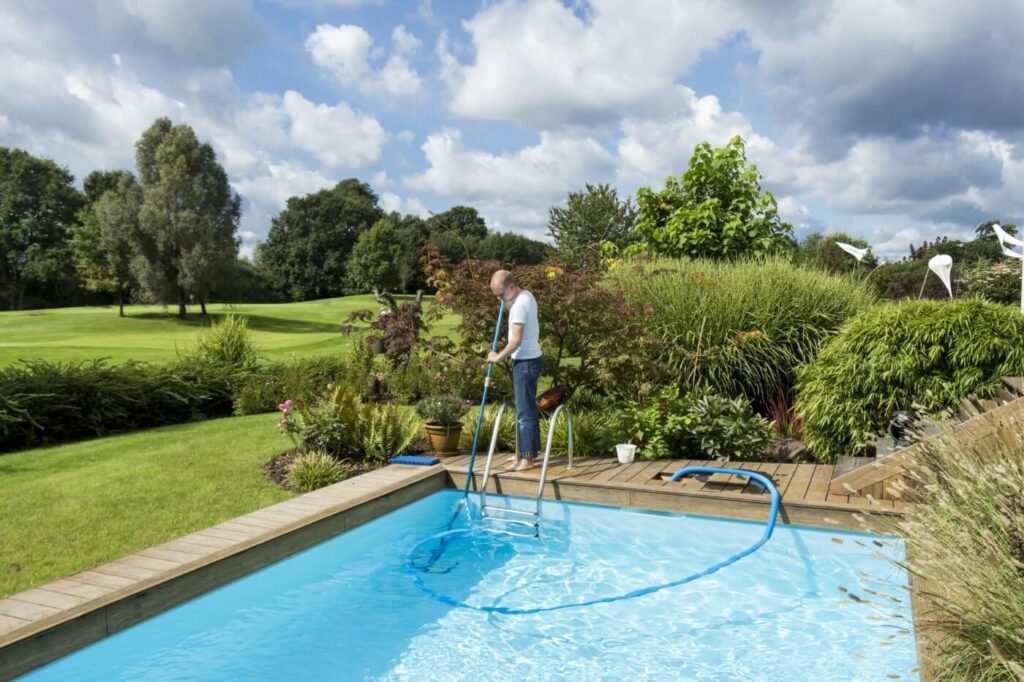
The summer of 2018 saw record heat waves across all 4 continents in the non-tropical Northern Hemisphere. As temperatures around the globe continue to rise, we’re all looking for a way to beat the heat. Having a pool is one way to ensure you always have somewhere to cool off. But how much work is pool maintenance?
Maintaining your pool consists of opening and closing your pool properly. It also involved a weekly and monthly pool maintenance routine. Keep reading to find out what you need to do to keep your pool running for all the hot summers to come.
How to Open Your Pool:
Unless you live somewhere where it’s summer all year round, you’ll need to open and close your pool. Let’s start with a pool opening checklist.
- Remove the pool cover.
- Clean the pool cover thoroughly.
- Store the pool cover where it won’t be torn or sun damaged.
- Fill your pool with water at a rate of 1″ per hour (don’t overfill it).
- Test the water for balance, pH, calcium, and alkalinity.
- Have an expert test and analyze your pool water to be sure.
- Inspect the pool for safety including electrical service, ladders, and diving boards.
- Check other components of the pool such as filters, skimmers, drains, plugs, and gauges.
- Make sure the fittings are lubricated.
- Clean tiles and skimmers.
- Clean the deck and inspect it for safety.
- Vacuum the pool and brush the sides.
- Backwash the filter.
- Shock the pool water.
Now that your pool is open and ready for swimming, you’ll want to maintain all that hard work.
Weekly Pool Maintenance:
Maintaining your pool means adopting a regular routine. Every week, you should complete the following steps to ensure your pool lasts as long as possible. Doing these things on a weekly basis will save you money in the long term. Without this routine, damage can add up.
Clean Your Pool of Debris:
Use a leaf scoop to remove any debris that accumulated in your pool – especially at the bottom of the pool. You should also remove any leaves and other debris from the skimmer and strainer-housing basket. Give the tile along the water line a good scrub as well. This will stop grime from building up.
Vacuum the Pool:
Vacuuming your pool will pick up any debris and dirt you can’t get with a leaf skimmer. It cleans your entire pool liner. Don’t know how to use your vacuum? We’ve got you covered. Once you’ve attached the vacuum hose and pole to the head of the vacuum, place it in the water at the bottom of the pool. Ensure that you’re holding the other end of the hose so that it can fill with water. You don’t want any air to get trapped in the vacuum. Still with the hose submerged in water, put the vacuum plate into your skimmer. There’s no need to remove the leaf basket when you do this. Attach the hose and the elbow fitting and start vacuuming.
Test Your Water:
One of the most important aspects of pool maintenance is the cleanliness and balance of your water. You should always have an eye on clarity, color, and visible contaminants. But you also need to test your water regularly. Every week, or more often if you notice visible issues, test the pH and alkalinity of your water. You can purchase pool water testing kits to help you with this step.
- The right pool water pH depends on the finish of your pool: Vinyl or tile finish – 7.4 to 7.7, Fiberglass finish – 7.3 to 7.5, and Gunite finish – 7.4 to 7.6.
You can adjust your pH using a pH decrease when the pH is too high. For pH that is too low, use a pH increase. Read the instructions of your product for the appropriate dosage. To Ensure that you don’t add pH increases or decreases more than once per week. You’ll want to check and adjust the sanitizer levels at the same time.
Add Cleaning Chemicals:
Once a week you should also test the chlorine levels. You can add chlorine tablets to your chlorinator as needed. As a general rule, your free chlorine levels should be between 1 and 3 ppm. Whereas bromine levels should be between 3 and 5 ppm. Clarifier should be added at a rate of 1 oz per 5,000 gallons of water. Algaecide can be added at the same rate.
Check Your Filter:
Backwash your filter when it’s needed. You should check the filter pressure as part of your weekly maintenance. Ensure that you rinse your cartridge filter as well. But this only needs to be done bi-weekly.
Check Water Levels:
Your water level is intricately tied to the pump. If the water level isn’t high enough, your pump won’t work properly. Ensure the water level is high enough and top up when needed. You should fill the water at a rate of 1″ every hour.
Shock the Water When necessary:
When you notice that your pool water isn’t clear or has a tint of green, it’s a good idea to shock the water. For every 5,000 gallons, add 1 lb of shock. This will kill any bacteria or organic contaminants.
Monthly Pool Maintenance:
Some items don’t require a weekly schedule. Every month that your pool is open, you should also be completing these maintenance tasks:
- Check calcium hardness and adjust accordingly.
- Check for dissolved solids and adjust accordingly.
- Clean your filter using chemical cleaners.
- Inspect and clean tile, grout, and sealant you have a saltwater pool, check the salt levels.
- Check your vinyl liner for any damage and fix these accordingly check concrete, gunite, and fiberglass pools for cracks or damage.
- Make sure the motor and pump seals are tight.
- Do a safety inspection on ladders, diving boards, and handrails.
Taking these monthly precautions is essential to a safe and functioning pool for many hot summers to come.
Closing Your Pool:
The last step to pool maintenance is properly closing your pool for the season. To do this, follow these steps:
- For 24-48 hours, run your filter continuously.
- Remove all fittings, including skimmer baskets, ladders, and solar blanketsLower the water level at a rate of 1″ per hour.
- Leave 6″ of water in the pool.
- Drain the pump, filter, and sanitizing equipment and blow out all the lines to prevent freezingLubricate valves and plugs.
- Clean and vacuum the pool.
- Cover the pool.
By taking these necessary steps, you’ll make opening your pool a whole lot easier.
Is Your Pool Well-Maintained?
Proper pool maintenance takes a thoughtful opening and closing process. It also requires weekly and monthly maintenance while your pool is open and in use. But maintenance is more than just keeping your pool clean, it also means keeping your pool safe.
For more tips on taking care of your pool, check out our blog.




